LThe story appears in all good biology textbooks. In 1848, British entomologists observed a color change in certain moths in a forest near Manchester (United Kingdom). Instead of their usual light gray, birch moths (Biston betaria) took on a dark gray, almost black color.
Over the next century, the exception became the rule. In 1954, all British moths turned dark. For what reason? Pollution has blackened the bark of the trees. To hide from birds, it is now better to wear dark-colored wings. The insect becomes a textbook case of the adaptation of a species to its environment through mutation and natural selection.
In the small world of evolutionary researchers, however, we knew that the emblem had some weaknesses. The experience failed in what we call replication, or the capacity to be reproduced. The phenomenon had certainly been observed throughout England, but nothing could exclude that the populations had “contaminated” each other. “Another problem was the lack of direct evidence of the role of predation in this evolution”adds Jonathan Waters, professor of biology at Otago University, in New Zealand.
Also read (2018) | Article reserved for our subscribers The butterfly, pollution and evolution
Read later
The academic’s team published, on October 24, in the journal Sciencean article “who completes the demonstration”greets Patrik Nosil, CNRS research director at the Moulis center (Ariège). On another insect: the stonefly, often called “pearl” or “stone fly”. The group has 2,000 species, spread across the globe. But it was two of its representatives that Jonathan Waters was interested in.
Wood and leaf residues
On one side Austropearla dark pearl with zebra legs which has the particularity of being toxic to those who consume it. On the other Zelandoperlajust as dark, similarly striped, but edible. Birds don’t know the difference. So Zelandoperla is protected by Austropearl. A phenomenon that science has named “Batesian mimicry” – in homage to its discoverer, Henry Bates (1825-1892). Edifying but common, not to say banal.
Read also | Article reserved for our subscribers Coprophagy, a health passport for birds
Read later
Except that New Zealand researchers discovered that some Zelandoperla had swapped their dark dress for a light tunic. By sequencing the individuals, they found that this change in costume corresponded to the mutation of a single gene. They especially observed that it had happened in areas where the forest had undergone massive cutting in recent decades, greatly reducing the population ofAustropearlwhich feeds precisely on wood and leaf residues. And they noted the same transformation on several sites totally isolated from each other.
You have 31.26% of this article left to read. The rest is reserved for subscribers.







